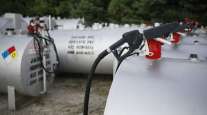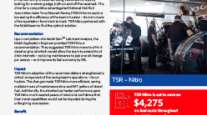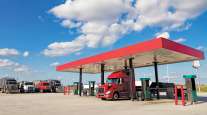Diesel Jumps 9.5¢ to $4.022
This story appears in the Feb. 11 print edition of Transport Topics.
Retail fuel prices rose significantly last week, with the diesel average jumping 9.5 cents a gallon to $4.022 — the largest spike since August — and gasoline leaping 18.1 cents — the most in nearly two years, according to the Department of Energy.
For diesel, it was the third straight increase, for a combined total of 12.8 cents, moving the average above the $4 mark for the first time since Dec. 3, DOE said after its Feb. 4 survey of fueling stations.
The agency placed part of the blame on refinery maintenance shutdowns.
These increases follow a 14-week period of declines when the national diesel average dropped to $3.894 on Jan. 14 from $4.15 on Oct. 15.
The 12-month low price for diesel was $3.648 on July 2, and a year ago the national retail average was $3.856.
DOE’s Energy Information Administration also said the retail gasoline average was $3.538, up from $3.357 the previous week.
This is the third straight year for a February gas spike. The price jumped by 13 cents a gallon last year and by 19.4 cents a gallon in February 2011. A year ago, gas averaged $3.482.
The leap in pump prices is the final step in a progression from crude oil futures contracts to wholesale prices to retail, said Denton Cinquegrana, an analyst for the Oil Price Information Service.
“We’re seeing the retail prices catching up to the wholesale prices, and then there are the refineries that are down this time of year for maintenance,” Cinquegrana said.
EIA petroleum analyst Timothy Hess said last week’s price jumps cannot be traced to a single cause.
“It’s a combination of factors coming together,” he said, but emphasized refinery shutdowns in particular. Hess said maintenance-related closings are normal this time of year, but that it can cause jitteriness among buyers and sellers.
Following changes in the NYMEX crude oil contract, heating oil futures have increased to nearly $3.20 a gallon last week from $2.90 on Dec. 10. Despite that 10% increase, diesel did not start rising until the second half of January. Heating oil is the high-volume commodity that is closest in nature to diesel fuel as both are middle distillates.
Crude oil futures prices in New York and London stabilized at the start of February. The NYMEX price rose to almost $98 a barrel on Jan. 30 from about $85.50 on Dec. 10, an increase of 14.5%. Since flirting with $98, prices have stalled, closing at $95.83 on Feb. 7.
From Dec. 7 to Feb. 1, the Brent price in London rose by 9.1% to $116.76 a barrel and closed at $117.24 on Feb. 7.
Two fleet executives told Transport Topics they were already feeling the pinch of higher prices.
“We buy the majority of our fuel in bulk for delivery to our terminals. It’s less than retail, but it jumped 21 cents a gallon over one week,” said Glen Merkel, president of Davis Cartage Co., Corunna, Mich.
Davis is a less-than-truckload carrier with 50 power units, and they never travel more than 250 miles from their central Michigan home, said Merkel. Over the years he has weeded out customers who refuse to pay a fuel surcharge, but his main strategy is to shop carefully for the fuel he buys in 12,000-gallon lots.
As a short-haul carrier, Merkel said, aerodynamic design is not particularly important because his trucks do not run at highway speed for long stretches.
“We saw the changes pretty quickly and felt the effects in our weekly numbers,” said Collin Stewart, CEO of Phoenix-based Stewart Transportation, adding that he follows fuel prices personally rather than delegating to an employee.
“We work closely with our vendors, the national [truck-stop] chains, and negotiate discounts,” said Stewart, whose company is mainly a refrigerated carrier.
Stewart, who also has 50 trucks, does run long distances throughout the nation, so he obsesses over miles per gallon. The company was recently able to get its average mileage to 7.25 mpg from 6.75 after working with drivers to reduce idling and to run slower.
Stewart said he is adjusting specifications for truck purchases and will probably move to automated manual transmissions “in the near future” because of the fuel efficiency the AMTs have demonstrated.
Hess said exports of refined products also keep diesel prices high.
“Distillate exports, including diesel, are about twice the level of gasoline exports,” he said. The nation’s refineries exported 1.08 million barrels a day of distillates for the week ended Feb. 1. During the same time in 2011 exports were 835,000 barrels a day.




